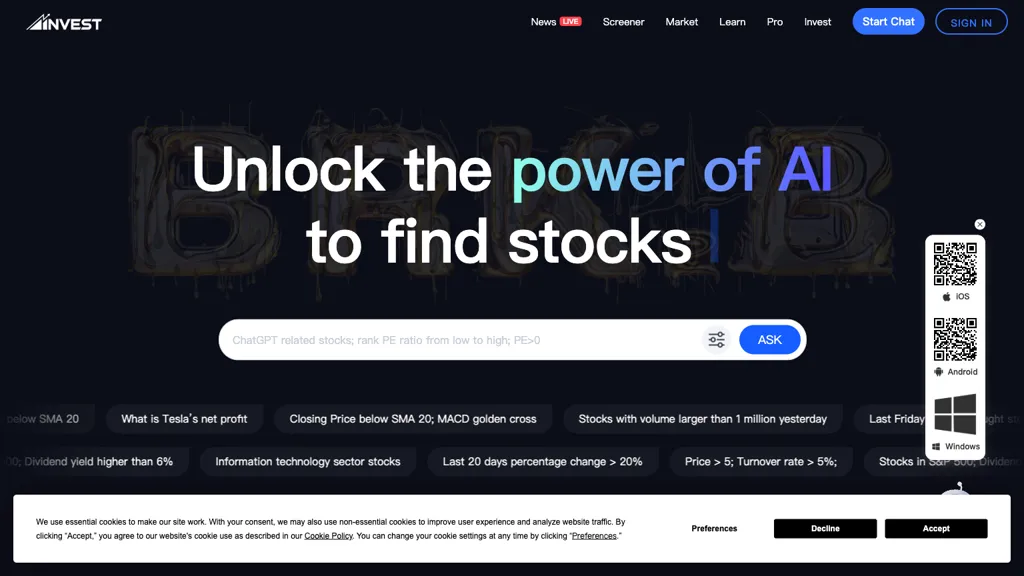20 Top Reasons For Selecting AI Stock Investing Platform Sites
20 Top Reasons For Selecting AI Stock Investing Platform Sites
Blog Article
Top 10 Tips On Assessing The User Interface And Experience In Ai Stock Analysing Trading Platforms
The User Interface (UI) and the User Experience (UX) of AI trading platforms that predict and analyze stocks are essential to ensuring efficiency, usability, and overall satisfaction. A poorly-designed interface can inhibit the process of making decisions, even when AI models underlying it are robust. Here are 10 tips for evaluating the UI/UX.
1. Assess the ease of use simple, intuitiveness and speed
Navigation: Ensure that the platform is easy to navigate, with easy-to-read menus, buttons and workflows.
Learning curve: Identify how quickly new users can be able to use and comprehend a platform without extensive training.
Consistency: Check for consistent design patterns (e.g. buttons, designs, colors, etc.)) across the platforms.
2. Look for customizability
Dashboard customization: Check whether dashboards are customizable to display charts, data and metrics that are relevant for the user.
Layout flexibility: Make sure your platform permits you to reorder widgets, charts and tables.
Themes: Find out the dark or light mode or any other visual preferences.
3. Visualize Data
Quality of chart: Ensure that the platform has interactive charts with zooming and panning functions (e.g. line charts, candlestick charts).
Visual clarity: Ensure that the data is clearly presented, with appropriate labels, legends, tooltips, etc.
Real-time Updates: Check to see if your visualizations reflect the most recent market data.
4. Test Speed and Response
Time to load: Make sure the platform loads quickly regardless of handling huge databases or complex calculations.
Real-time Performance: Check if your platform is able to process data feeds with no lag.
Cross-device compatible: Verify that the platform runs seamlessly on every device including mobile, desktop and tablet.
5. Evaluate accessibility
Mobile App: Ensure the platform has an app for trading on the go with full functionality.
Keyboard Shortcuts: Check that your device supports keyboard shortcuts.
Accessibility features. Verify that the platform is in compliance to accessibility standards.
6. Test Search and Filter Functionality
Search function: Make sure that the platform you use allows you to search quickly for indexes, stocks and other investments.
Advanced filters: Determine whether the user is able to apply filters to produce results that are more specific (e.g. by capitalization, sector, performance metrics).
Saved search: Check if the platform permits users to save searches frequently used and filters.
7. Check for Alerts and Notifications
Customizable alarms: Make sure users can set up notifications for specific conditions.
Notification delivery - Check if alerts are sent out via multiple channels.
Timeliness - Check that alerts are generated quickly and accurately.
8. Examine Integration with Other Tool
Broker integration: Make sure that the platform is integrated seamlessly with your brokerage account for simple trade execution.
API access: Find out the API access for advanced users. the API to create their own tools or workflows.
Third-party integrations: Check whether the platform allows integrations with other software (e.g., Excel, Google Sheets and trading bots).
9. Take a look at the Support and Help Features
Tutorials on boarding: See if the platform provides tutorials or walkthroughs for new users.
Help center: Ensure that the platform is equipped with a complete support center or knowledge base.
Customer service: Examine to see if the platform provides responsive customer support.
10. Test Overall Test Overall
User feedback: Utilize reviews and feedback from users to determine their overall satisfaction with the platform's UI/UX.
Trial period: Take advantage of a free trial or demo to try the platform out for yourself and test its effectiveness.
How does the platform deal with errors and edge cases?
Bonus Tips
Aesthetics. It is crucial to have a functional layout, but a visually appealing layout can improve the user experience.
Testing the performance of the platform under extreme stress to make sure that it's responsive and stable during times of high volatility.
Forums and communities Forums and communities: Find out if the platform has an online community or forum that allows users to discuss comments and suggestions.
These tips will help you evaluate the user interface and UX of the AI trading platforms that predict and analyze stocks to ensure they're user-friendly efficient and in tune with your trading needs. A good UI/UX will greatly increase your capacity to make informed choices and effectively execute trades. Check out the top chatgpt copyright hints for more info including trading with ai, ai stock trading app, ai investing, ai for stock trading, ai stock trading, ai investing, ai for trading, ai stock trading, ai for trading, best ai stock trading bot free and more.
Top 10 Tips For Assessing The Regulatory Conformity Of Ai-Powered Stock Predicting/Analyzing Trading Platforms
Regulatory compliance plays a crucial role in evaluating AI platforms for analysis and prediction of stocks. Compliance assists in ensuring that the platform is operating in compliance with legal guidelines and protecting personal data of the users. Here are 10 best suggestions to evaluate the regulatory compliance on these platforms.
1. Verify Registration and License
The regulatory bodies: Make sure that the website is licensed and registered by the appropriate financial regulatory authority (e.g. SEC, FCA, ASIC, etc.) in your country.
Broker partnership: If the platform integrates with brokers, verify that the brokers are also licensed and properly regulated.
Public records: Visit the website of the regulator to find out whether the platform is registered or if it has any time violated the law.
2. Review Data Privacy Compliance
GDPR: Make sure that your platform is compliant with the General Data Protection Regulation.
CCPA: California Consumer Privacy Act compliance is mandatory for all users.
Policies on handling data. Check the privacy policy to ensure it clearly describes the ways in which data regarding users is used to collect, share, and kept.
3. Examine Anti-Money Laundering(AML) measures
AML Policies: Make sure the platform is governed by AML policies that are able to identify and stop money laundering.
KYC procedures: Determine if the platform uses Know Your Customer (KYC) which validates user identities.
Examine the platform's monitoring of transactions. Does it track transactions and report suspicious activity to the authorities?
4. Verify that you're in compliance with Trading Regulations
Market manipulation: Check that the platform includes measures to protect against manipulation of the market like spoofing or wash trading.
Types of orders: Verify that the platform is compliant with the regulations applicable to the types of orders (e.g. there is no stop-loss hunt).
Best execution: Check to see if the website follows the best execution practices, which ensures that trades will be executed at the lowest possible price.
5. Assessment of Cybersecurity's compliance
Data encryption: Ensure that the platform protects data during the transfer process and in rest, using encryption.
Incident response: Verify if the platform has a clearly defined incident response plan for data breaches or cyberattacks.
Certifications - See whether your platform holds any cybersecurity certifications.
6. Transparency and disclosure: A Review
Disclosure of fees - Make sure all fees are disclosed, even extra charges or hidden costs.
Risk disclosure: Check if there are clear and explicit disclosures about risks, specifically for high-risk or leveraged trading strategies.
Performance reporting: Check if the AI platform's models are clear and accurately reported.
7. Verify the compliance to International Regulations
International trading When you trade internationally, ensure that the platform you use is in compliance with all regulations.
Tax reporting - Find out if a platform provides tools and reports that help users to comply with tax regulations.
Compliance with international sanctions: Ensure that your platform is in strict compliance with these and doesn't allow trading between countries or entities that are banned.
8. Assess record-keeping and audit trails
Transaction records: Make sure the platform keeps detailed records of all transactions to be used for audits and regulatory purposes.
Recordings of user activity: Check whether the platform records the user's activity, including logins and trades, as well as any changes to the account settings.
Check for audit readiness: Determine whether your platform is able to provide the required logs and documentation in the case of an inspection by a regulatory agency.
9. Evaluate Compliance with AI-Specific Regulations
Algorithmic Trading Rules: If your platform supports trading using algorithms, ensure that it is compliant with the regulations such as MiFID II (in Europe) or Reg SCI (in the U.S.).
Fairness and bias: Determine whether the platform is able to monitor and reduces biases in its AI models to ensure fair and ethical trading.
Explainability: Certain laws require that platforms give explanations for AI-driven predictions or decisions.
Review User Feedback & Review History of Regulatory History
User reviews: Use feedback from users to assess the platform's regulatory conformity.
Regulatory history: Check whether the platform has a past history of violations by the regulatory authorities, fines, or penalties.
Third-party Audits: Verify that the platform is subject to third-party inspections to make sure it's in compliance with all regulations.
Bonus Tips
Consultations with a lawyer: You may consider consulting a lawyer in order to establish if the platform meets applicable regulations.
Trial period. You can use the trial or demo of the platform to test its compliance features.
Customer Support: Ensure that the platform has assistance to customers with any questions or issues with compliance.
These suggestions will assist you to assess the compliance of AI trading platforms that forecast or analyze the prices of stocks. In this way, you'll be able to pick a trading platform that works within the legal frameworks and protects your. The compliance not only reduces the risk of legal liability, but also increases confidence in the platform's services. Have a look at the most popular https://www.inciteai.com/advisors for site info including free ai stock picker, ai trading tool, best ai trading platform, ai for trading stocks, how to use ai for copyright trading, best ai for stock trading, best ai stocks, stock predictor, best stock prediction website, ai software stocks and more.